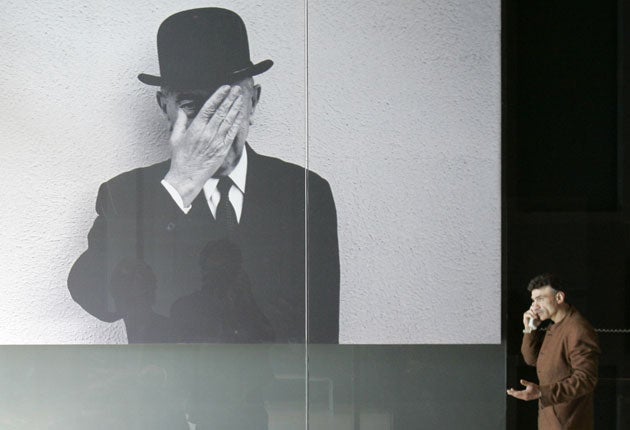It's so Surreal... the artist who forged himself
A new exhibition shows how Margritte could copy. But was it clever irony or just desperation?

Your support helps us to tell the story
From reproductive rights to climate change to Big Tech, The Independent is on the ground when the story is developing. Whether it's investigating the financials of Elon Musk's pro-Trump PAC or producing our latest documentary, 'The A Word', which shines a light on the American women fighting for reproductive rights, we know how important it is to parse out the facts from the messaging.
At such a critical moment in US history, we need reporters on the ground. Your donation allows us to keep sending journalists to speak to both sides of the story.
The Independent is trusted by Americans across the entire political spectrum. And unlike many other quality news outlets, we choose not to lock Americans out of our reporting and analysis with paywalls. We believe quality journalism should be available to everyone, paid for by those who can afford it.
Your support makes all the difference.One is an original. The other, evidently, a copy. But René Magritte was a Surrealist, and the truth behind The Flavour of Tears suggests he was enjoying a huge – and probably lucrative – joke.
The canvases – both dated 1948 – come together for the first time in Britain later this month as part of The Pleasure Principle, Tate Liverpool's exhibition of the Belgian artist's work, and the story behind them throws light on the artist's early struggles.
When the artist painted the original, he had survived the Second World War in German-occupied Belgium, but was unknown and broke. He had just come to the end of what is called his Renoir period, which lasted from 1943-1947.
Darren Pih, the exhibition's co-curator explained: "He was very serious about these works, but he was not a rich man in the 1940s. Only in the 1950s did his reputation soar, his work really begin to sell, and his quality of life improve."
Experts are now certain that the paintings are both Magritte originals, and believe he faked his own work to raise cash.
The question of forgery only arose in 1983 when one of the paintings came up for auction in New York. Until then, the art world had been unaware of the existence of both pictures because one had been shipped to the United States while the other remained in Europe.
The Flavour of Tears was produced around the time Magritte's close friend Marcel Mariën claimed Magritte was creating forgeries. In his 1983 autobiography, Le Radeau de la Mémoire, Mariën said Magritte was making money by selling and producing forgeries of works by Picasso, Titian, Max Ernst, Giorgio de Chirico and Meindert Hobbema.
Phi says: "When Marcel Mariën published this text, he was taken to court by Magritte's widow. She contested the claim. Marië* was a close friend of Magritte: they met in 1937 and he wrote the first biography [of Magritte], and he was someone who really understood the artist's thinking. But they did fall out in the 1960s. We can't say that there were other forgeries, although there is some proof and correspondence that Mariën cited."
Phi believes that two collectors saw The Flavour of Tears independently in Magritte's studio. "We can only assume Magritte painted two identical versions of the same painting. Their similitude is such that even the inscriptions on the back of the canvases are the same. It's a real mystery as to how this came about."
Mariën says the replica had been faithfully reproduced, "right down to the holes made by a caterpillar".
Pih believes that Mariën was describing the way in which Magritte created variations of his work. "This was really informed by the art market, producing works for collectors, he said. "He is known to have produced multiple versions of the same work. In most cases he would evolve, improve and refine the image, but this is the only example where they are almost identical works."
Pih also points to the fact that forgery and plagiarism are often considered as central themes in Surrealism. The original and the "forgery" shed light on the painter himself, according to Phi. "He had a very anarchic sense of humour. That sense of an anonymous, bourgeois man in a grey suit wearing bowler hat. His humour and his work are subversive."
When art copies art
The Flavour of Tears is established as a bona fide original, but René Magritte and his fellow Surrealists were no strangers to the dark arts of forgery. Magritte made a living during the Nazi occupation of Belgium by forging Picassos and Renoirs. Fellow artist Marcel Mariën would sell them on to private collectors.
The Surrealist movement explores the tension of the real and the unreal, and Magritte may well have seen his forgeries as part that conflict. Playing a joke on the aficionados, he hung his forgery of Max Ernst's The Forest in place of the original in 1943.
Fellow Surrealist Giorgio de Chirico, in his later years, produced what he called "self-forgeries" of his earlier, more popular style. He would backdate them to fool the critics; ironic revenge for their attacks on his later works.
Join our commenting forum
Join thought-provoking conversations, follow other Independent readers and see their replies
Comments